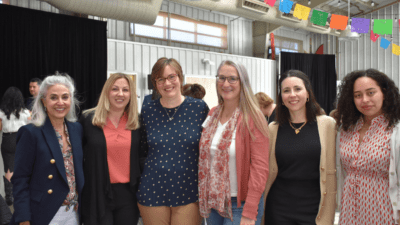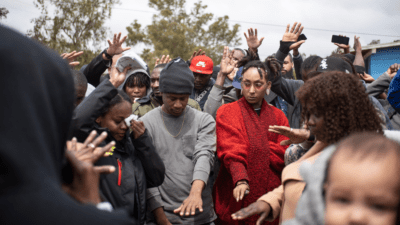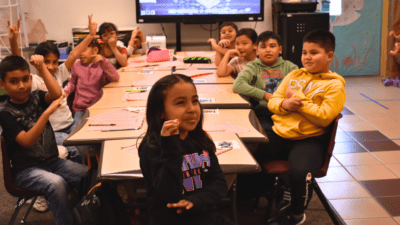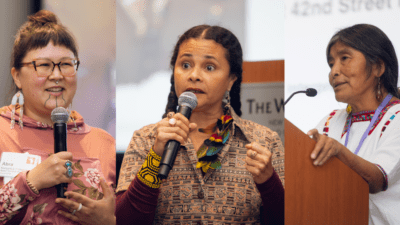“Más que Palabras,” or “More Than Words,” is a collaboration between 11 newsrooms and 13 Report for America corps members to examine how language barriers in the Latino population play out in almost every aspect of people’s lives. Reporters for Más que Palabras work to identify the challenges that individuals and communities face, response from local and state governments, and enterprising initiatives being implemented to address this issue.
WKKF’s Director of Communications, Kathy Reincke, recently spoke with Wilson Liévano, managing editor at the GroundTruth Project and Report for America, to learn more about the behind the scenes of “Más que Palabras.”
Kathy: What was the idea behind this series on the impact of language barriers on the social, economic and educational opportunities for Latinos?
Wilson: We wanted to put a spotlight on an issue that many Latinos experience but that is rarely spoken about. There is a large population of immigrants that speak limited or no English and struggle to access opportunities and services because there’s no information or outreach in their language.
A Clinton administration executive order mandates all agencies that receive federal funds to offer language services, but in practice few do and in many cases it’s not enough, due to systemic issues tied to the lack of representation for Latinos.
In our series we wanted to explore how these barriers affect immigrants at every level. From visiting the doctor’s office to helping their kids thrive in school and even paying their taxes, while also highlighting some promising approaches by local organizations, governments and individuals that are looking to break these barriers.
Kathy: There were many reporters and media outlets participating in this storytelling series. Can you tell us how many participated and how far this series reached?
Wilson: The project grew out of conversations we had with several Report for America host newsrooms. We noticed that this problem repeated itself in multiple ways across the country. We asked for proposals for stories related to the topic, and 11 newsrooms responded to the call, with 13 corps members participating in the project.
Having a sizable number of newsrooms and reporters in the project allowed us to do stories on multiple communities across America. Our coverage went from San Diego to Yakima Valley in the West Coast to DeKalb in Illinois, and we also included several stories in North Carolina and Connecticut in the East Coast. It was exciting to see how corps members in different states approach a topic like health care for Latinos from their local perspective but connecting the issue to the overall topic.
Kathy: What issues that Latino communities face did your reporters discover in this series? Were there similar issues or do the issues vary differently based on location?
Wilson: The language barriers take multiple forms, but the challenges for immigrants are similar regardless of where they live. For example, reporters found that although some hospitals and health care professionals are starting to offer translation services, it isn’t a widespread practice and even in cases where there is a translator present, a lot of the medical nuances can get lost in translation, increasing the risk of a misdiagnosis or patients not following the treatment correctly. Some hospitals are implementing a model that pairs certified medical interpreters with doctors for long periods of time, helping them learn how the doctor communicates and increasing the accuracy of their translation.
Another pressing issue is education. There are thousands of kids who arrived in the country without knowing English and for them, succeeding in school can be extra challenging – even more so if their parents also don’t speak the language. Bilingual education is on the agenda of many states, but there’s a scarcity of bilingual teachers. States can’t seem to agree on what is the best model for English Learning, with some counties employing five or six different approaches with various degrees of success – resulting in uneven learning and different educational outcomes for kids.
The language barrier also manifests when victims of domestic violence need support but can’t find someone who speaks their language, or when immigrants who work long hours want to find activities and social connections for their elderly parents but discover that there are no programs for them in other languages at their local community centers.
Our corps members found that in many cases this relates to stereotypes about the Latino community and culture that prevent organizations from doing outreach or offering services that would help. In elder care, for example, there’s the assumption that Latinos like to take care of their parents at home. This can be true in their countries of origin, but not for immigrants without a support system. Older Latinos are left feeling increasingly isolated and depressed. It’s even more worrisome in cases of elder abuse, where the victims don’t even know where to start asking for help.
In their reporting, the corps members noticed that the most successful approaches to integrate and offer services to non-English speakers went beyond just offering translation services, into incorporating a cultural awareness that helped service providers break through the fear and distrust that many immigrants experience.
Learn more and explore the Más que Palabras series.
Read more about Report for America.








Comments